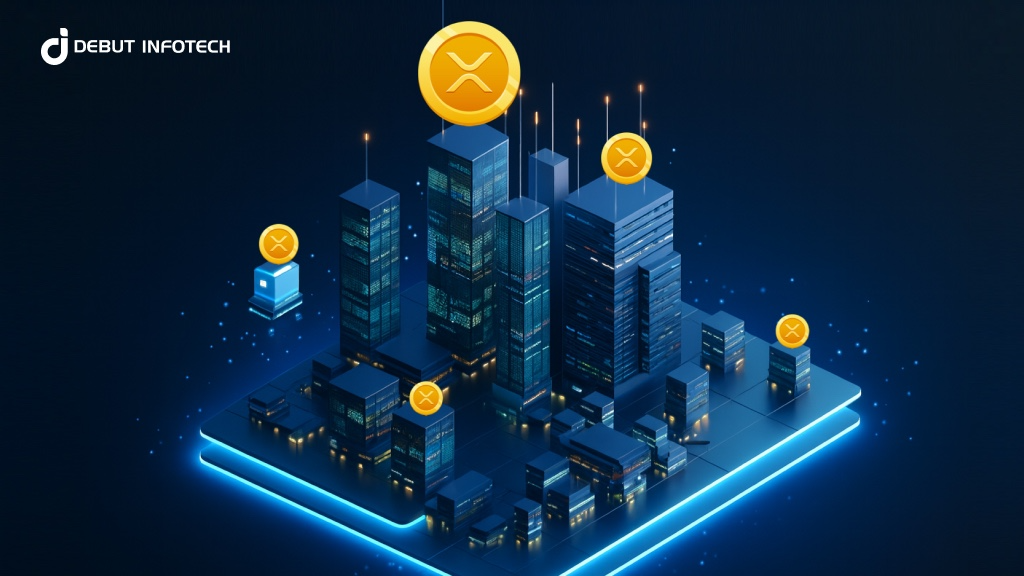Are you trying to launch a real estate tokenization project?
You must have noticed that the real estate industry is trapped in costly, slow, and extremely illiquid systems.
Nonetheless, real estate tokenization, which turns assets into tradable units on blockchain networks, is starting to disrupt the game in 2025. The XRP Ledger (XRPL), which includes initiatives like the XRPL $1B tokenized fund, is gaining interest among these due to its speed, efficiency, and institutional traction.
In this article, we are discussing the significance of XRPL, the major developments influencing tokenized real estate in 2025, and the advantages it provides to forward-thinking CEOs like yourself.
Let’s dive in.
Understanding the Relevance of XRPL in Real Estate Tokenization in 2025
Despite the huge earning potential that the real estate industry possesses, its day-to-day operations still experience inefficiencies such as illiquid assets, slow and expensive transactions, and restricted investment opportunities.
In 2025, real estate tokenization is one of the modern ways through which these issues are being addressed.
So, what is real estate tokenization?
Put simply, it is the process of converting the ownership rights of a real-world property into digital tokens that can be traded on the blockchain. This is the core of real estate tokenization development, enabling both property owners and investors to benefit from fractional ownership and improved liquidity. Be it a residential building, office space, or commercial property, real estate tokenization makes it easy to represent these real estate assets digitally as fractions of ownership on a blockchain. As a result, each individual unit can now be traded just like shares or stocks.
Wondering why anyone would want to do that?
Tokenizing real estate assets enables fractional ownership, instant settlement, and expanded access to investment opportunities. Not only that, tokenization also lowers barriers to entry, brings liquidity to previously illiquid assets, and creates new models for property financing.
So, where does XRPL fit into all these?
You see, the XRPL is a decentralized blockchain with over ten years of demonstrated dependability. As such, it is renowned for its speed and cheap transaction fees.
Furthermore, XRPL has a history of managing large volumes of transactions without experiencing any downtime, in contrast to more recent blockchains that are still developing their infrastructure. In addition, its energy-efficient consensus process fits nicely with the ESG principles that real estate funds and investors are becoming more and more interested in.
That’s why XRPL has been emerging as one of the most practical platforms for tokenizing real estate assets in recent times. Not only was the platform designed for digital currencies, but it is also capable of issuing and managing a wide range of tokens that can represent real estate assets.
So, why has this been pivotal in 2025?
Let’s look at some key 2025 trends in XRPL-powered real estate tokenization.
Key 2025 Trends in XRPL-Powered Real Estate Tokenization
The XRPL (XRP Ledger) has been on an upward trend as a foundation for real estate applications due to the combined effect of different converging factors.
The following are some of those key 2025 trends:
1. Growing Regulatory Alignment
One of the main reasons why many real estate owners are increasingly finding it easy to depend on the XRPL platform for their real estate tokenization is that regulators have been almost effectively reinforcing their idea of tokenization by providing clear frameworks of operation.
For a long time now, tokenization of real estate assets has been reduced due to the absence of regulations. But now, frameworks such as the U.S. pilot programs for digital asset securities and the European Union’s MiCA rules are providing much-needed certainty in 2025. And because XRPL’s architecture provides tokenized assets with inherent transparency and traceability, it is especially well-suited for compliance.
2. Institutional Entry into Tokenized Funds
With clear regulatory statutes in place, it has become relatively easier for institutions and corporate entities to dive into real estate tokenization.
Large-scale, regulated financial products can now operate on XRPL, as we have seen with recent announcements like the XRPL $1B fund tokenized and tests with an XRPL tokenized money market fund. This is important to real estate decision makers because it shows that investors have faith in the ledger’s capacity to handle substantial, tangible value. In fact, the legitimacy of property-backed projects increases by association if major funds have faith in XRPL for financial instruments.
3. Fractional Ownership has Become Mainstream
Despite the opportunity for institutional participation, it’s almost safe to say that the real estate investment process has never seen this much participation from individuals belonging to different economic classes ever before.
You see, the ability to split ownership into more manageable, smaller parts is one of the most alluring features of real estate tokenization. This trend is picking up speed in 2025 as a result of growing demand from individual investors looking for alternative assets.
And since these fractional properties share tokens on XRPL can be issued and traded swiftly and affordably, opening up real estate to a wider range of investors, from international investors seeking diversification to millennials just starting out in the market.
4. Greater Liquidity Through XRPL’s AMM Feature and DEX
The fact that fractional ownership has become mainstream means one major thing: there’s going to be so much capital injection into the real estate market. In turn, this means greater liquidity through XRPL’s AMM feature and DEX.
Unlike stocks or bonds, purchasing or selling real estate takes months. Clearly, this is because real estate assets are usually higher in value and more expensive.
This issue is addressed by XRPL’s native decentralized exchange (DEX) and its more recent automated market maker (AMM) feature, which together enable the nearly instantaneous exchange of tokenized property assets. Because it increases capital efficiency and opens up secondary market opportunities, this is especially crucial for executives overseeing sizable funds or portfolios.
5. Increase in Interoperability and Cross-Border Investments
Despite the growing globalization of real estate investing, cross-border transactions are still sluggish and complicated by middlemen. Of course, emerging FinTech solutions and blockchain platforms are actively trying to solve the problem. However, these core infrastructural issues are still very much existent.
In response to these challenges, moving tokenized assets between networks and jurisdictions is made possible by XRPL’s work on sidechains and interoperability bridges. This trend suggests a future in which tokenized real estate in Singapore, Dubai, or New York may be accessible and exchanged via the same XRPL-powered ecosystem, all while adhering to regional regulations, for developers and investors.
6. Enhanced Security and Custody Solutions
With those infrastructures and many others in place, it has been relatively easier to secure the platform during tokenization. In fact, the advancements have led to enhanced security and greater custody solutions even with simple platforms.
Nevertheless, investors must be reassured that their digital ownership is just as secure as conventional deeds or certificates for tokenized real estate to grow. By 2025, new custody and compliance solutions that offer secure property-backed token storage are contributing to the maturation of the XRPL ecosystem. Furthermore, larger participants, such as family offices and real estate investment trusts (REITs), who were previously hesitant because of security concerns, are now drawn in by these advancements.
So, how are these advancements and trends amplifying XRPL’s relevance in real estate tokenization?
Find out in the next section.
Competitive Advantages of using XRPL for Real Estate Tokenization in 2025
As a business executive looking to choose a blockchain platform for any real estate tokenization exercise, there are some technical, strategic, and financial advantages that you could benefit from using XRPL.
The following are some of them:
1.Proven reliability and market trust
In contrast to many more recent blockchains, XRPL has been up and running for over ten years. Institutional confidence in its infrastructure is demonstrated by this track record as well as the recent introduction of programs like the XRPL $1B tokenized fund and the XRPL tokenized money market fund. Being linked to a ledger that regulated funds trust enhances a real estate project’s credibility with investors.
2. Low costs and faster transactions
High transaction fees and middlemen frequently slow down real estate transactions. Consequently, overhead is greatly decreased by XRPL’s low cost structure and almost instantaneous settlement. As a result, capital that would otherwise be locked in drawn-out settlement cycles can be released when tokenized property assets are distributed as XRPL tokens, allowing them to flow swiftly between parties.
3. Liquidity through built-in features
Tokenization’s primary promise is still liquidity. One of the few blockchains that allows real-time trading of tokenized assets is XRPL, which also has a native decentralized exchange (DEX) and an AMM feature. Because tokenized property shares can be actively exchanged in liquid secondary markets, they offer CEOs a level of freedom that traditional real estate structures cannot equal. For them, tokenized property shares are more than just digital placeholders.
4. Sustainability and ESG Alignment
Sustainability indicators are being used more and more to evaluate real estate investment. XRPL is significantly less resource-intensive than proof-of-work blockchains since it employs an energy-efficient consensus method. This can be a differentiation for funds that sell tokenized assets to investors that care about ESG.
5. Global reach through interoperability
By nature, the real estate industry is already global. However,tokenized assets can now interface with other ecosystems thanks to XRPL’s sidechain and bridge projects, which are facilitating cross-chain interoperability. This gives real estate companies the chance to draw in foreign investors without making back-office operations more difficult.
Conclusion
Clearly, real estate tokenization is fast transitioning from concept to competitive advantage. When you look at the growing institutional adoption, legislative clarity, and XRPL-driven innovation around the real estate industry, then you can see the changes.
That’s why selecting the appropriate asset tokenization development company is crucial for executives who are prepared to investigate real world asset tokenization. As one of the top real estate tokenization companies out there, Debut Infotech, provides white label tokenization platforms and customized token development, putting customers in a position to take advantage of XRPL’s full potential in property, equity, and fund tokenization.
Ready to take over the real estate industry?
Caroline is doing her graduation in IT from the University of South California but keens to work as a freelance blogger. She loves to write on the latest information about IoT, technology, and business. She has innovative ideas and shares her experience with her readers.






